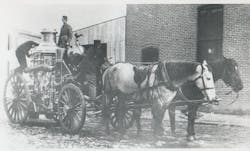Rekindles 9/2011
PARIS, FRANCE: SEPT. 1, 1911 – Father Abbe Daney, a priest in the Landes region of France, near Bordeaux, saw local parishioners suffer the devastating loss of their 12-acre pine forest, so this ecclesiastical and would-be scientist and inventor began three years of experiments trying to make a better fire extinguisher. Turning his presbytery into a chemical laboratory, he began rigorous trials, several of which had near-catastrophic outcomes. Finally, he developed an apparatus that used hydraulic pressure to force a fine spray of a special liquid salt that turned to gas at 150 degrees Fahrenheit. The extinguisher apparently was effective from a great distance. For his efforts, he was awarded the Cross of the Legion of Honor by the French government. This prestigious award was established by Napoleon Bonaparte in 1802.
JUNEAU, AK: SEPT. 4, 1911 – The Juneau Hotel caught fire and burned furiously, severely taxing responding firemen. Mutual aid was requested to Douglas and the firemen joined forces as the flames extended to the McGrath Building. In all, 11 people lost their lives in the flames and 14 were injured, including two critically.
ANTWERP, BELGIUM: SEPT. 13, 1911 – A fire broke out in a large lumber yard and spread with amazing speed until five vast wood yards were ablaze. Flames spread to a railroad depot and several homes, burning them to the ground. All the firemen in the district were battling the fire and soldiers from a nearby garrison were ordered to aid in firefighting efforts.
RIO DE JANEIRO, BRAZIL: SEPT. 14, 1911 – A huge fire destroyed the Imprensa Nacional (National Printing Works) building and some extremely rare and valuable items stored within the structure. Among the items lost to the flames were valuable archives, catalogs of historic newspapers, many first editions and original copies of important books.
NEW YORK CITY: SEPT. 19, 1911 – During a small cellar fire at 62 West Houston St. in Manhattan, a new firefighting invention was put to the test. Designed by Fireman James D. Halloran of Engine Company 23 (detailed to Engine 20), the device was a garden hose reinforced with spiral wire and stretched from the street with the fire hose. The end of the hose was attached close to the nozzle with smaller hoses branching off to nose cups that were fitted to the face of the nozzle team. As water passed through the attack line, the pressure caused a “Venturi effect,” pulling outside air through the small hose to the firemen inside. This initial test was declared a success as the hose team was able to push in and extinguish the fire while breathing the smoke-free outside air. The commissioner said testing of the device would continue.
NEW YORK CITY: SEPT. 24, 1911 – Blinded by smoke, Battalion Chief William Devlin fell from the roof while operating at a blazing two-story building at 506 Broome St. in Manhattan. The fire originated in the stockroom of Lion Knitting Works, which occupied the second floor. Firefighting efforts were hampered by dense smoke, so the 42-year-old chief led a team to the roof of an adjoining building to chop a hole through the roof of the fire building. Devlin misstepped and fell onto the roof of a small storm shed below. He was removed unconscious and taken to St. Vincent’s Hospital, where he died four days later. Sadly, Devlin was a widower and left behind five children.
TOULON, FRANCE: SEPT. 26, 1911 – The 440-foot-long French battleship Liberte was at anchor in Toulon harbor when a fire was discovered in the starboard bow magazine. Immediately, heroic firefighting operations commenced. The crew attacked the fire with hoses and attempted to flood the burning magazine. Despite the crew’s valiant efforts, the extending flames could not be halted. At 5:53 P.M., flames spread to the main magazines, setting off a horrific explosion. The devastating blast tore the pre-dreadnought battleship apart, killing 204 officers and men. The blast showered nearby ships with flaming debris, causing extensive damage, additional fires and explosions that claimed the lives of nearly 100 more people. Despite fears of sabotage, the fire was believed to have started by spontaneous combustion in nitrocellulose gel, a preferred propellant for the large guns aboard French Navy ships.
WICHITA, KS: SEPT. 27, 1911 – A fire broke out in a broom-corn stalk house on East Douglas at about midnight. The Wichita Fire Department arrived on scene and began battling the blaze. About an hour into the operation, a brick wall collapsed, killing Fireman W.C. McFall and injuring five others.
AUSTIN, PA: SEPT. 30, 1911 – After two weeks of heavy rain, the huge dam of the Bayless Pulp and Paper Co. failed, sending more than 400 million gallons of water rushing down the valley toward the small town of Austin 1½ miles away. The wall of water crashed into the business section of town so quickly most people had no chance to flee to higher ground. Many of the town’s buildings were constructed of wood, and those that were not immediately destroyed by the torrent were soon in flames. It was estimated that 1,000 buildings were destroyed by the flood and fire. Close to one-third of the town’s 3,200 residents were killed by the devastating flood and fire. Farther down the valley, little Costello, a town of 450 people, was also swept away.
